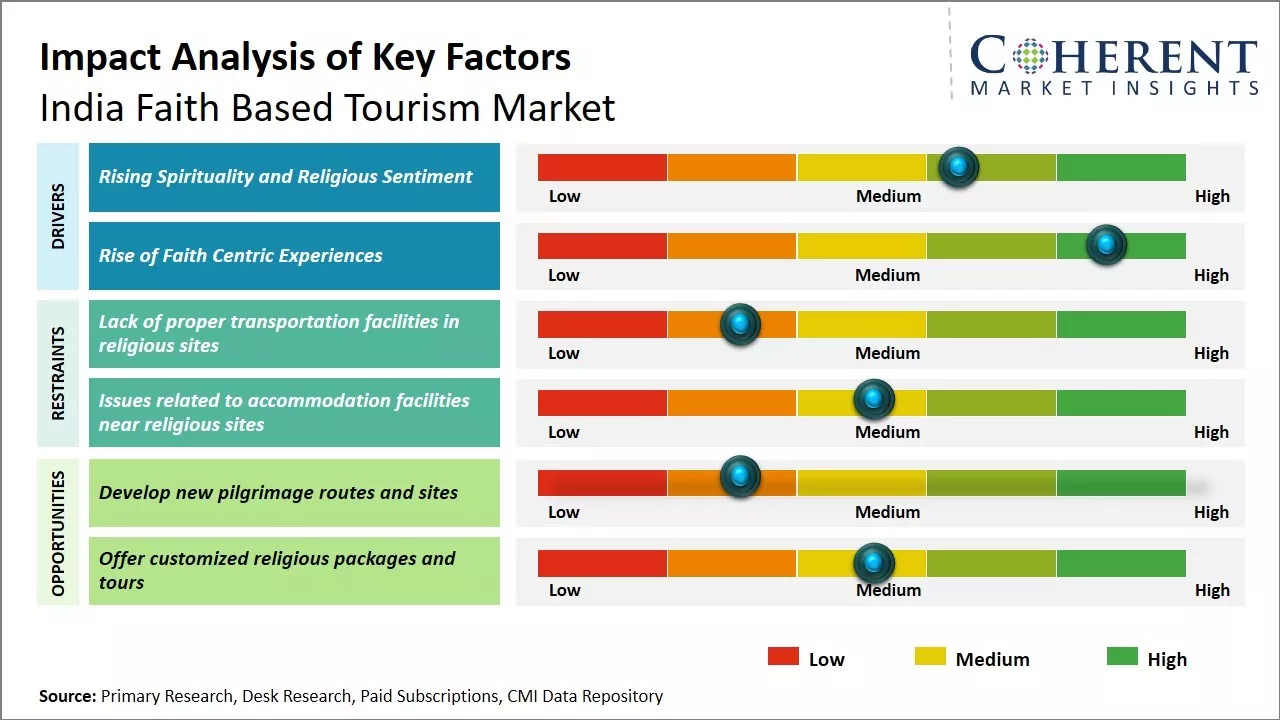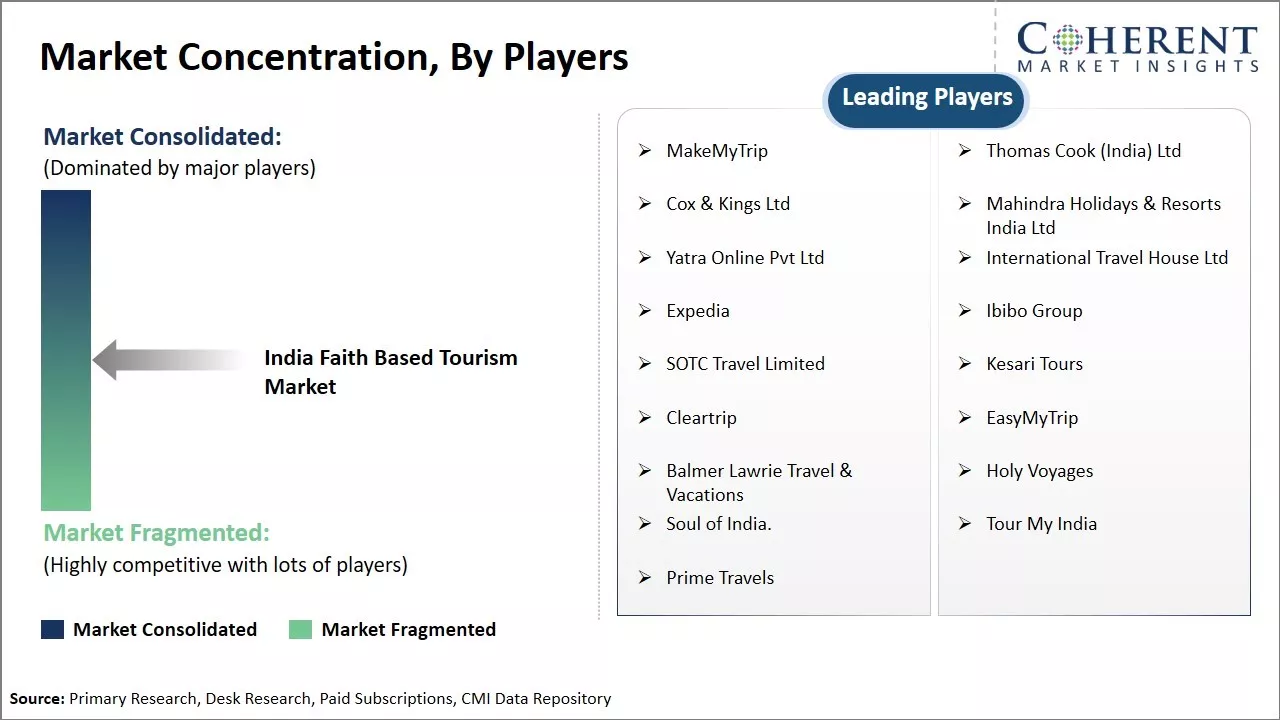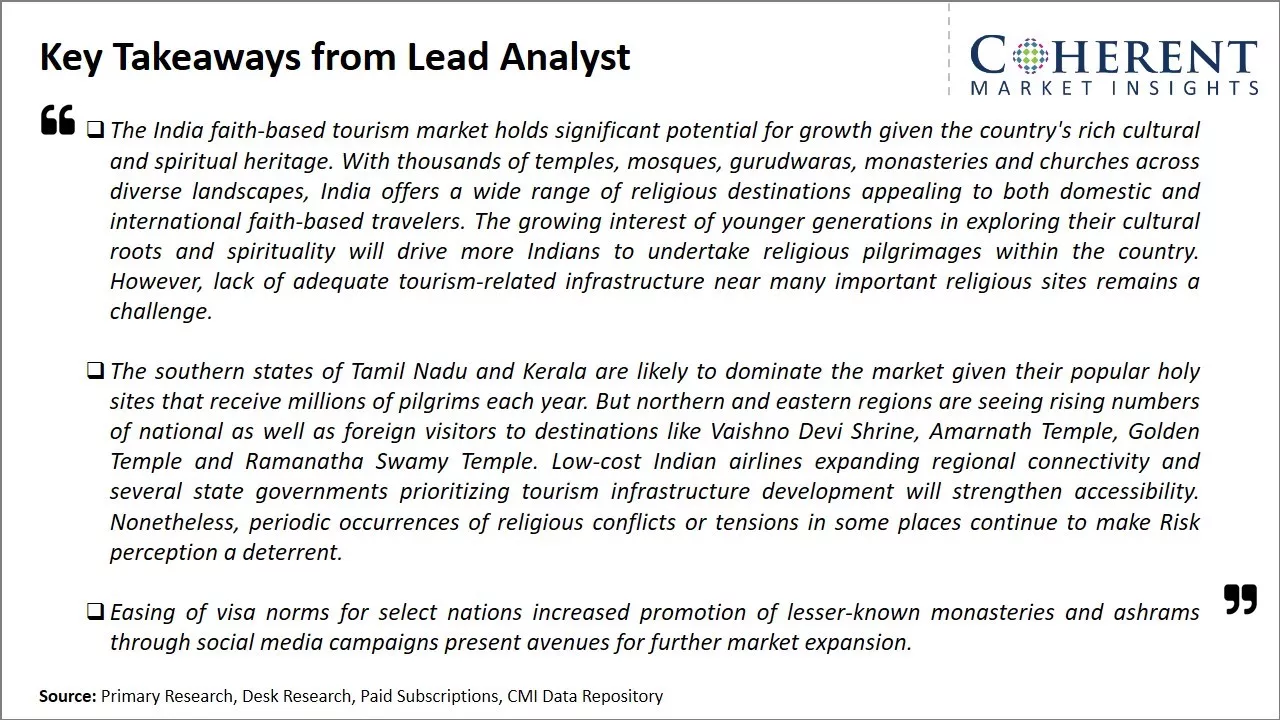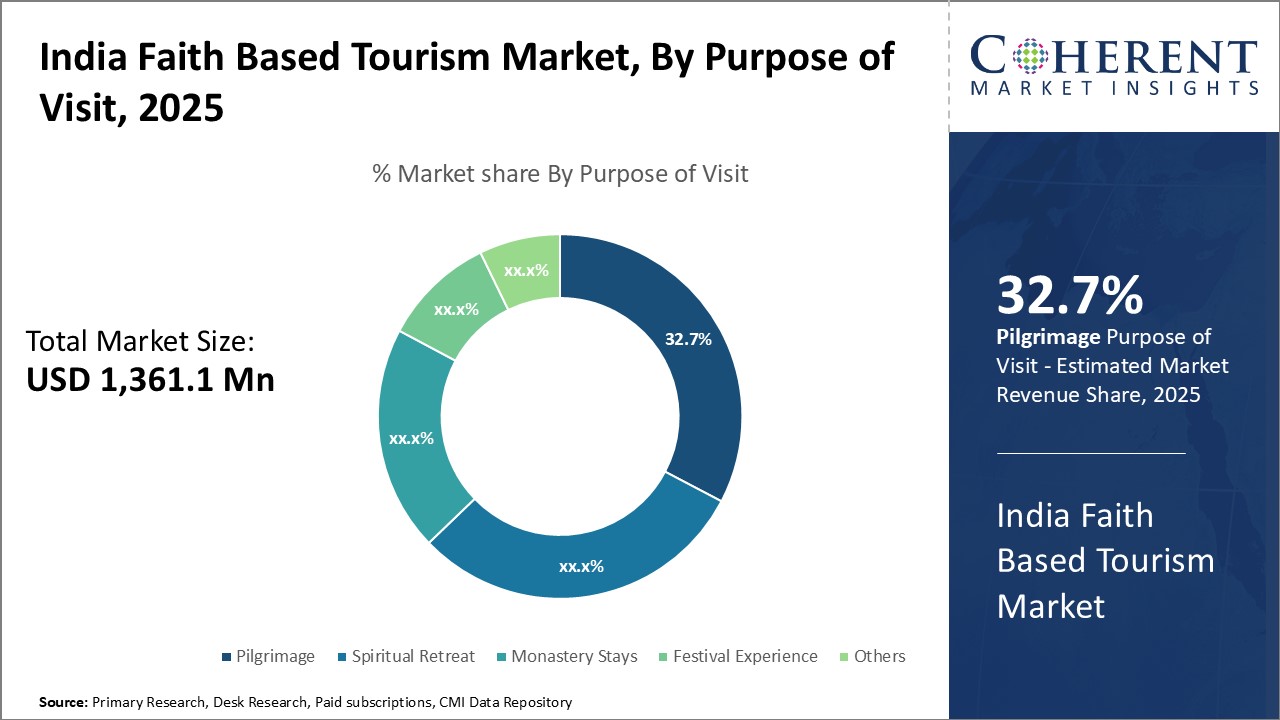India Faith Based Tourism Market Size and Trends
The India faith-based tourism market is estimated to be valued at USD 1,361.1 Mn in 2025 and is expected to reach USD 3,689.5 Mn by 2032, growing at a compound annual growth rate (CAGR) of 15.3% from 2025 to 2032.

Discover market dynamics shaping the industry: Download Free Sample
Faith based tourism is an important segment in India's tourism industry, with many popular religious destinations that attract domestic and international devotees. The market is expected to witness positive growth over the forecast period driven by increasing disposable income and willingness of people to spend on religious trips. Various government initiatives to improve infrastructure and promote religious tourism are also driving more visits to popular pilgrimage sites. However, market growth can be impacted by risks such as social and political instability or pandemic outbreaks affecting travel.
Rising Spirituality and Religious Sentiment
As India progresses economically, there has been a rise in disposable incomes and increased standard of living. In this era of rapid urbanization and modernization, ancient practices and value systems that gave comfort and guidance are slowly disappearing. More and more people feel disconnected with their roots and are left searching for meaning and purpose. This is driving them to explore their spiritual and religious sides for answers. While megacities offer a plethora of distractions and entertainment, they fail to fulfill one's emotional and mental well-being. People are discovering that mere material wealth cannot guarantee happiness and peace of mind. They want to break away from their mundane routine and hectic schedules to indulge in activities that nourish their soul. Visiting religious places of worship allows them to find inner peace, draw strength from faith, and reconnect with their culture and heritage. It is a way for introspection and meditating in spiritual environs away from daily hustle bustle. The serenity and positive energy in temples and other holy sites work wonders in reducing stress and elevating mood. Pilgrimage tourism allows people to undertake sacred journeys, perform rituals, and receive blessings they believe will fulfill destinies. Several circuits are gradually becoming popular faith-based routes that follow footprints of ancient gods and teachings of religious gurus. Performing rituals, which often include circumambulation of temples, nature trails, community prayers, and fasting elicit strong emotions. For many, it marks an important life event or occasion of celebration and offering of prayers. The shared spiritual experience in group pilgrimages fosters camaraderie and strengthens social bonds as well. In effect, it is emerging as a means to discover inner self and connect at a deeper human level with fellow travelers.
Market Concentration and Competitive Landscape

Get actionable strategies to beat competition: Download Free Sample
Rise of Faith Centric ExperiencesIndia is home to many religions and spiritual heritages that attract millions of national and international pilgrims every year. The varied faith based places of worship and pilgrimage sites enable India to emerge as one of the global hubs of faith based tourism. Visits to shrines and temples are an integral part of people's spiritual journey in India. Some of the major faiths prevalent in India like Hinduism, Buddhism, Jainism, Sikhism and Islam have countless religious sites that have been drawing devoted followers for ages. For example, places like Varanasi, Haridwar, Rishikesh, Ajmer Sharif, Mathura, Amritsar, Dharamshala, Sarnath attract pilgrims throughout the year for spiritual and religious activities like rituals, prayers, offerings etc as per the customs. In recent times, India has also witnessed increasing visits by international tourists who want to experience the diverse faiths and gain spiritual insights during their tourism. Going forward, the government of India has recognized the enormous potential of faith based tourism and is taking targeted efforts to develop infrastructure and facilitate amenities at major pilgrimage destinations. For instance, projects like development of Kedarnath temple under the 'Shri Kedarnath Udhyam Tirath Pariyojana' and Rejuvenation and Spiritual Augmentation of Pilgrimage Destinations (RASPD) will enhance the tourism infrastructure and ensure a satisfactory pilgrimage experience. This in turn drives more domestic and international tourists towards such religious circuits.

To learn more about this report, Download Free Sample
Market Challenges: Lack of proper transportation facilities in religious sitesOne of the major factors hindering the growth of faith-based tourism in India is the lack of proper transportation facilities near important religious sites. Many holy pilgrimage destinations, especially in rural areas, do not have adequate infrastructure to transport large numbers of domestic and international tourists. The lack of coordinated multi-modal transport linkages between railway stations, bus stations and the actual religious sites force pilgrims to rely on inconvenient and costly private transport options. This discourages families and older visitors who find difficulty in navigating between modes of transport while carrying luggage and provisions. According to the Ministry of Tourism, government of India, nearly 60% of important sites like temples, churches, mosques, and gurudwaras lack proper amenities and signage, and over 25% do not even have basic access by public transport within 5 kilometers. This poor connectivity acts as a deterrent for visitors and restricts the number of pilgrims being able to access these destinations easily and comfortably.
Market Opportunities: Develop new pilgrimage routes and sites
Developing new pilgrimage routes and sites can provide a huge opportunity to boost faith-based tourism in India. India is home to many major religious sites for religions like Hinduism, Buddhism, Sikhism, Jainism, and others. However, there are still plenty of lesser-known temples, monasteries, and shrines that have significant religious importance but have not been developed well for tourism. Establishing better routes, infrastructure, and amenities to access such currently obscure sites can expose many more domestic and international devotees to India's rich spiritual heritage. For example, there are numerous Jain holy sites scattered across Rajasthan that remain rather inaccessible today. Developing circuit routes connecting temples like Shikharji, Ranakpur, Kumbhalgarh, etc. along with enhancing facilities at each stop can encourage pilgrims to experience the diverse architectural and spiritual influences across this region. Similarly, Buddhist trails in Ladakh and the northeast which weave through monasteries, caves, and mountain passes holding religious significance present tremendous scope. The Union Ministry of Tourism's Pilgrimage Rejuvenation and Spiritual, Heritage Augmentation Drive (PRASHAD) scheme, launched in 2020, recognizes the need to boost accessibility and promotion of off-beat pilgrim destinations.

Discover high revenue pocket segments and roadmap to it: Download Free Sample
Insights, by Purpose of Visit: Devotion and SpiritualityPilgrimage is expected to contribute 32.7% of the market share in 2025 under the purpose of visits segment within the India faith-based tourism market. This is due to the deeply religious nature of Indian culture and society. India has long held significance as a center of various faiths, most notably Hinduism, Buddhism, Sikhism, Jainism, and Islam. For Hindus in particular, pilgrimage sites dotted across the Indian subcontinent hold immense spiritual and cultural importance. Visiting temples, shrines, rivers, and other holy places is considered an important spiritual practice and duty in Hinduism. Some of the most prominent pilgrimage destinations in India include Varanasi, considered one of the holiest cities for Hindus due to its association with the Ganges River. Millions visit Varanasi each year to perform funeral rites, pray, and immerse ashes of departed loved ones. Rishikesh in Uttarakhand also sees high pilgrim footfall as the entry point for treks to Char Dham pilgrimage centers. Allahabad hosts the gigantic Kumbh Mela festival once every 12 years where millions of Hindu, Jain, and Sikh devotees converge for a holy dip in the confluence of Ganga, Yamuna, and the mythical Saraswati. The far-flung Himalayan pilgrimage circuit of Gangotri, Yamnotri, Kedarnath, and Badrinath dubbed Char Dham also attracts a huge number of devotees each season. The promise of spiritual merit and forgiveness of sins attached to pilgrimages profoundly motivates millions of Indians to undertake often arduous journeys each year. Families also consider inter-generational pilgrimage an important cultural tradition to inculcate religious values in children. With growing mobility and infrastructure improving access, pilgrimage tourism in India continues to rise steadily on account of the population's deep religiosity.
Insights, by Type of Amenities: Guided Tours are Driving Experiential Faith-based Travel in India
Among type of amenities, guided tours is expected to contribute 31.7% of the market share within the India faith based tourism market in 2025. This can be attributed to the growing demand for more experiential and immersive pilgrimage experiences beyond just religious sites. Tour operators are increasingly curating specialized pilgrimage packages with value-added services and expertise to provide contextual religious information, safe transportation, accommodation bookings, and security and safety assurances for devotees of all ages and abilities. Specialized tour packages tailored for different religious circuits now incorporate knowledgeable English and local language speaking guides. These guides are well-versed in the mythology, rituals, and historic relevance of various temples and shrines. Guides also offer logistic assistance and ensure proper access according to religious customs. This has made pilgrimages more comfortable for both domestic and international visitors unused to Indian conditions. Many operators also organize experiential tours incorporating local culture, nature experiences, volunteer activities and exposure to spiritual philosophies and teachings along pilgrimage routes. In recent times, demand has also surged for specialized interest-based tours like yoga, wellness, and detox retreats integrated with visits to ashrams, temples or isolated forest hermitages. These provide a holistic mind-body experience beyond just "ticking off" religious destinations.
Market Report Scope
India Faith Based Tourism Market Report Coverage
| Report Coverage | Details | ||
|---|---|---|---|
| Base Year: | 2024 | Market Size in 2025: | USD 1,361.1 Mn |
| Historical Data for: | 2020 To 2024 | Forecast Period: | 2025 To 2032 |
| Forecast Period 2025 to 2032 CAGR: | 15.3% | 2032 Value Projection: | USD 3,689.5 Mn |
| Segments covered: |
|
||
| Companies covered: |
MakeMyTrip, Thomas Cook (India) Ltd, Cox & Kings Ltd, Mahindra Holidays & Resorts India Ltd, Yatra Online Pvt Ltd, International Travel House Ltd, Expedia, Ibibo Group, SOTC Travel Limited, Kesari Tours, Cleartrip, EasyMyTrip, Balmer Lawrie Travel & Vacations, Holy Voyages, Soul of India., Tour My India, and Prime Travels |
||
| Growth Drivers: |
|
||
| Restraints & Challenges: |
|
||
Uncover macros and micros vetted on 75+ parameters: Get instant access to report
India Faith Based Tourism Industry News
- In January 2024, Oyo to Add 400 New Properties to Push Religious Tourism
- In March 2024, UP religious tourism gets Rs 85K cr boost: Ayodhya, Varanasi top gainers
- In March 2024, PM inaugurated projects to boost religious tourism
- In 2023, Kerala launched multilingual microsites for boosting religious tourism
- In 2023, Shri G. Kishan Reddy launched ‘Best Tourism Village Competition Portal’, Global Tourism Investor Summit 2023 Portal and Rural Tourism Portal in New Delhi
*Definition: The India faith-based tourism market refers to the market for tourists who travel within India to visit religious sites and participate in faith-based activities and festivals. It includes both domestic and international tourists visiting pilgrimage destinations across India associated with major religions like Hinduism, Islam, Sikhism, Jainism, Buddhism, and Christianity. Key faith-based tourism circuits in India promoting places of worship, rituals, celebrations and cultural heritage sites attract millions of religious tourists each year, contributing significantly to the country's tourism.
Market Segmentation
- Purpose of Visit Insights (Revenue, USD Mn, 2020 - 2032)
-
- Pilgrimage
- Spiritual Retreat
- Monastery Stays
- Festival Experience
- Others
- Type of Amenities Insights (Revenue, USD Mn, 2020 - 2032)
-
- Overnight Facilities
- Guided Tours
- Transport Rentals
- Food Services
- Souvenir Shops
- Others
- Key Players Insights
- MakeMyTrip
- Thomas Cook (India) Ltd
- Cox & Kings Ltd
- Mahindra Holidays & Resorts India Ltd
- Yatra Online Pvt Ltd
- International Travel House Ltd
- Expedia
- Ibibo Group
- SOTC Travel Limited
- Kesari Tours
- Cleartrip
- EasyMyTrip
- Balmer Lawrie Travel & Vacations
- Holy Voyages
- Soul of India.
- Tour My India
- Prime Travels
Share
Share
About Author
Yash Doshi is a Senior Management Consultant. He has 12+ years of experience in conducting research and handling consulting projects across verticals in APAC, EMEA, and the Americas.
He brings strong acumen in helping chemical companies navigate complex challenges and identify growth opportunities. He has deep expertise across the chemicals value chain, including commodity, specialty and fine chemicals, plastics and polymers, and petrochemicals. Yash is a sought-after speaker at industry conferences and contributes to various publications on topics related commodity, specialty and fine chemicals, plastics and polymers, and petrochemicals.
Missing comfort of reading report in your local language? Find your preferred language :
Transform your Strategy with Exclusive Trending Reports :
Frequently Asked Questions
EXISTING CLIENTELE
Joining thousands of companies around the world committed to making the Excellent Business Solutions.
View All Our Clients
